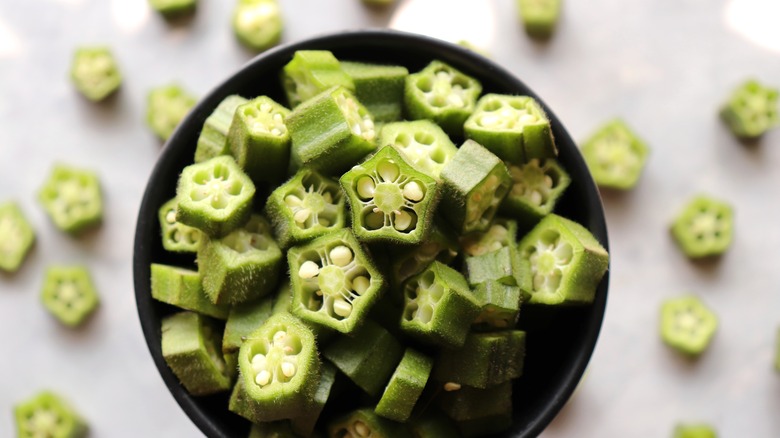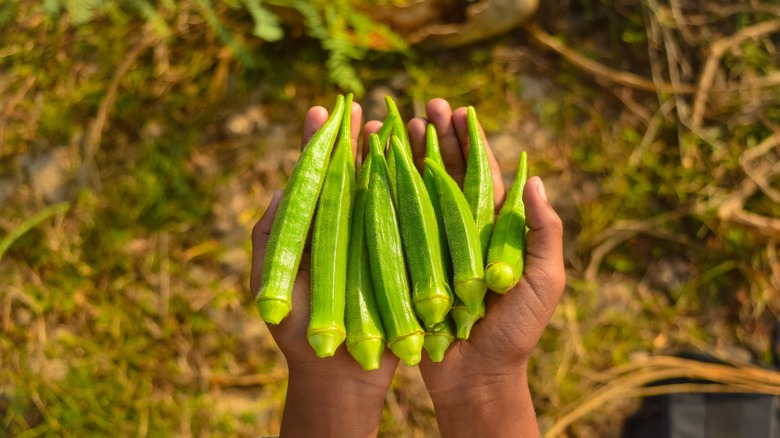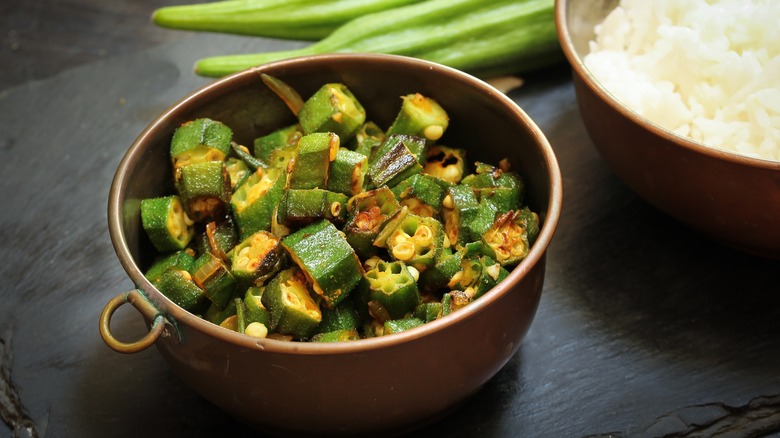The Temperature Tip That Will Prevent Slimy Okra
A mainstay in Southern cuisine, okra is a versatile vegetable that can be used as an ingredient in plenty of dishes or as a side item for meat and vegetables. Chop up some okra and mix it with rice and seafood for a gumbo; combine it with tomatoes for a stewed side. Alternatively, you can batter it and toss it in the frying pan for an appetizer that can be eaten on the go. However, one of the drawbacks to okra is its sliminess. It's enough to make dinner guests turn their noses up at the vegetable.
If you don't want your okra looking like it just attended a Nickelodeon Kids Awards Show, you can reduce the slime by being mindful of its cooking temperature. Especially if you're planning on grilling or frying okra, then you will want to flash fry the vegetable. Get your pan nice and hot before adding in the veggies. Don't commit the cardinal sin of allowing your okra to heat slowly as the pan does — instead, you want to get a good blast of heat from the get-go. The quick exposure to high heat will not only provide a nice crust, but it also has the added benefit of helping to reduce the okra's slimy nature, leaving you with a more palatable veggie.
What makes okra so slimy?
To understand how to make okra less slimy, first, you need to understand exactly why okra is slimy in the first place. The inside of okra is made from a sugar fiber, and the slime is a natural jelly created by the plant. That jelly is called mucilage and is featured in other plants like aloe vera and many cactus varieties, but it's particularly known for giving okra its unique texture. This mucilage can be beneficial to diners — for instance, it can help ease constipation and other digestive issues, according to the Sustainable Food Center. However, it's not everyone's cup of tea.
You may be tempted to just wash away the slime, but that will probably backfire and have the opposite results, as you'll find out if you try to rinse your okra in the sink. In his book "Veg-Table," author and biologist Nik Sharma explains, "Water draws out the mucilaginous substance, and pieces of okra might end up sticking to your knife and cutting board. The more water they meet, the stickier they get" (via Bon Appétit). Heat works for the opposite reason: It helps to dry out all that moisture inside of the okra and break down the sugars that form this jelly. However, high heat isn't the only way to pare down the slime in okra — for extra crispy results, you may want to combine flash-frying with another slime-reducing technique.
Other ways to reduce okra's slime
How you go about prepping your okra really comes down to what you're planning on using it for and how you're planning to cook it. If you're planning on using okra in a gumbo or stew, then its slimy nature may actually be a benefit; the sugar within okra lends itself to making a base for other ingredients. Additionally, you don't have to worry about a layer of slime in your gumbo because most of the vegetable's mucilage will likely cook out by the time it's done.
If you want a firmer texture for your okra, however, take a cue from the Southern staple of tomatoes and okra. The tomatoes balance out the natural texture of the okra because of the natural acidity in tomatoes: Acid helps break down the sugar in the okra, making the vegetables firmer and less slimy. That acid doesn't have to be from tomatoes — prior to cooking, consider splashing a bit of lemon or another citrus on your vegetables. You could also go with vinegar if you have a preference. Combine that with a quick flash fry, and your okra will be crispier than ever.


